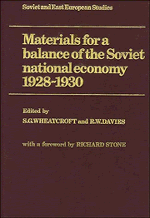Book contents
1 - THE STRUCTURE AND CONTENT OF THE ‘MATERIALY’
Published online by Cambridge University Press: 26 October 2011
Summary
The ultimate aim of Materials for a Balance of the Soviet National Economy 1928–1930 was to produce an elaborate tableau économique for the whole Soviet economy. The work as completed in 1932 was, as the authors declare in their preface, ‘only a first attempt’. The methodology was not fully worked out. Data were often inadequate. The volume was produced in haste. While the authors seek to explain what they are doing quite fully, their explanations are often confused, and they are distributed more or less stochastically between Pervukhin's article and the notes on pp. 256–311, 441–60. The tables themselves are presented in four bundles, reproduced in chapter 3 of Materialy: section I (Summary tables), section II (Constituent elements in the balance), section III (Integrated tables in the balance) and the four tabular appendixes of section V. This division has a certain logic, but the logic proves to be complicated and elusive.
We resisted the temptation to rearrange all the tables and the explanatory notes into a systematic order. Materialy is an important collection of documents in the history of Soviet planning, and in the circumstances of its time was an outstanding achievement. We have no right to tamper with it; the reader will wish to explore it in its original form. But to spare you from some of the agonies we have suffered in trying to understand the interconnection between the tables and their statistical foundation, we have provided this summary guide to the tables and the explanatory notes.
- Type
- Chapter
- Information
- Publisher: Cambridge University PressPrint publication year: 1985



